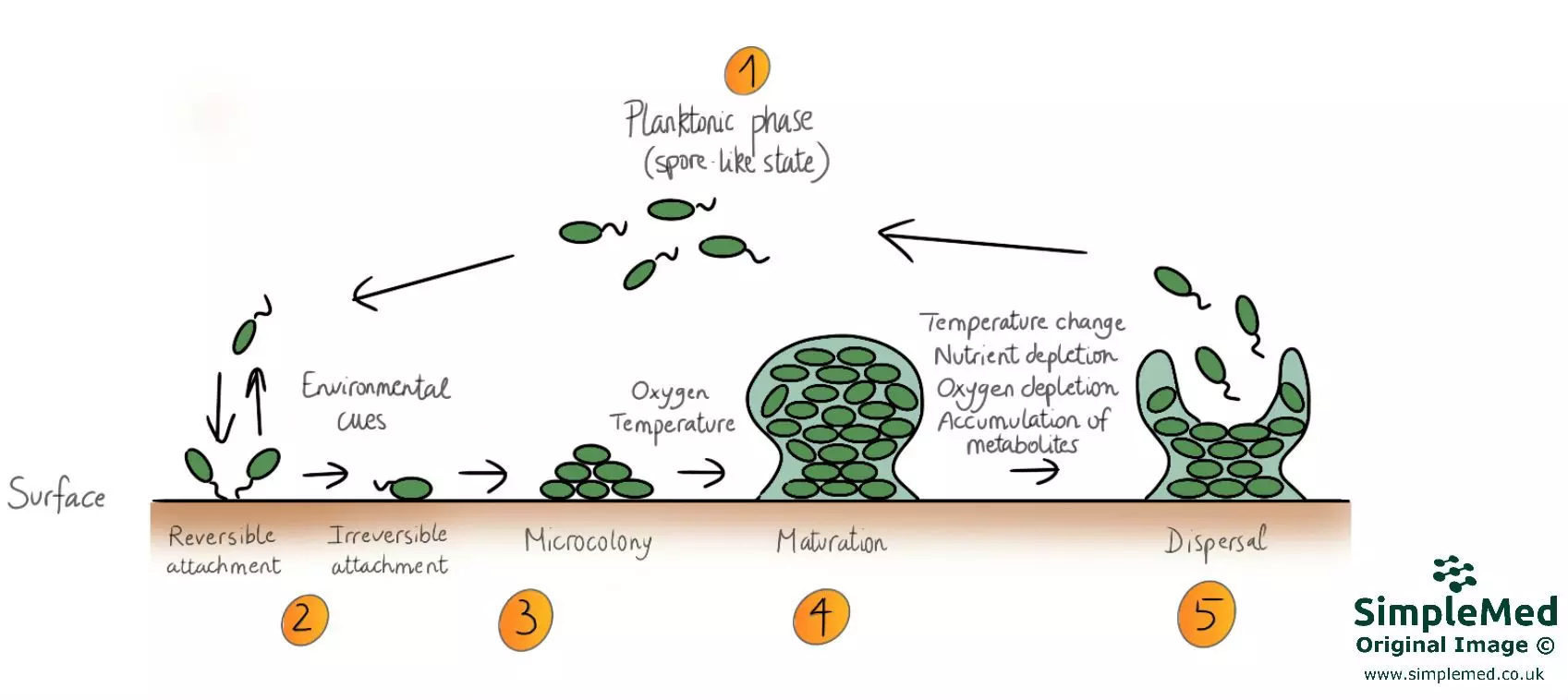Next Lesson - Innate Immunity
Abstract
- Biofilms are a way in which bacteria arrange themselves to be able to stick to surfaces and survive in adverse environments. This is done by forming an encapsulating slimy extracellular matrix made of extracellular polymeric substances.
- Clinically, bacteria often use biofilms to lodge themselves on indwelling devices and to protect themselves from the immune system within the body.
- The management of biofilms mainly focuses on prevention since they are hardly affected by antibacterial treatment.
Core
What are Biofilms?- Quorum sensing- quorum sensing is the modulation of gene expression in response to changes in cell population density (i.e. are there enough bacteria to carry out a process). These processes include; biofilm formation, sporulation and virulence factor release.
- Release of a signal- known as an autoinducer when a quorum (critical number of bacteria required) has been reached
- A receptor for the signal- on the bacteria to carry out the process
- A switching mechanism- to alter gene expression to carry out the process

Diagram: The formation of Biofilms on a surface, showing each step in their formation
Biofilms are a major cause for concern in hospitals where they are responsible for a considerable share of healthcare acquired infections. The cause of a biofilm based infection is usually iatrogenic. Common routes include indwelling devices, mechanical ventilators, intravascular lines, urinary catheters, prosthetic heart valves or orthopaedic implants. The issue is further compounded by the fact that many of these instruments eg ventilators, are used in critically unwell patients who are already more susceptible to infection. The organisms responsible for infection are usually commensal bacteria living; on the surface of the skin, in upper respiratory tract, in lower gastrointestinal tract or urogenital tract. When moved from their usual niche to a different part of the body or given opportunity to do so by a medical device they may become pathogenic. Two common examples are Staphylococcus epidermidis and Staphylococcus aureus.
Let’s go through a few common examples worth knowing about:
Prosthetic valve endocarditis: a serious complication of cardiac valve replacement surgery is prosthetic valve endocarditis (PVE). This results in an infection of the endocardium (inner lining of the heart). The most likely causative organisms vary depending on the onset of infection relative to the time of operation:

One of the substances secreted by biofilms are virulence factors. As mentioned above quorum sensing is the modulation of gene expression in response to changes in cell population density. Bacteria within the matrix produce signal molecules known as autoinducers (AI). Some of the signals induced include expression of virulence factors such as beta lactamases and exotoxins. These make bacterial colonies more resilient to immune attacks and antibiotics, contributing to their virulence.
The efficacy of antimicrobials to treat biofilms is limited because:
- Most antimicrobials lack the ability to penetrate biofilms.
- Biofilms on prosthetic joints have a poor blood supply making it difficult to achieve a high concentration of antimicrobial.
- After the switching process has occurred the bacteria have a slower metabolism and do not divide as rapidly reducing antimicrobial effectiveness.
Therefore sterilisation is key to prevent biofilm formation and persistence on indwelling devices or unsterile equipment; this includes any prosthetic material.
Patients that have been infected should have a sample taken so the microorganism can be identified and tested for its antimicrobial susceptibilities to prescribe the most effective agent.
Edited by: Dr. Marcus Judge and Dr. Ben Appleby
- 11023

